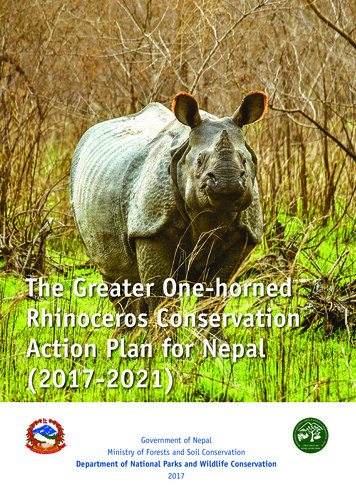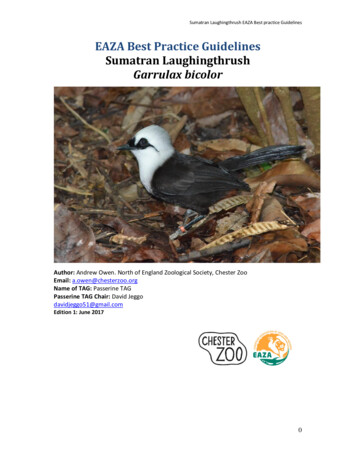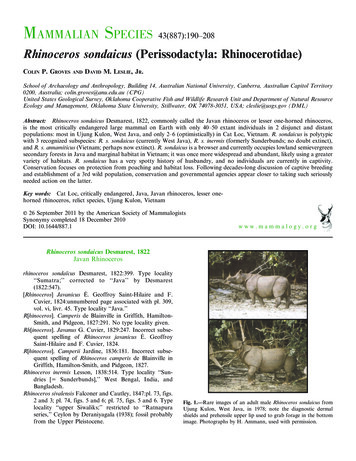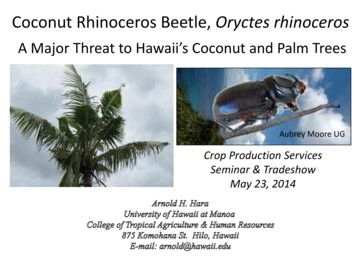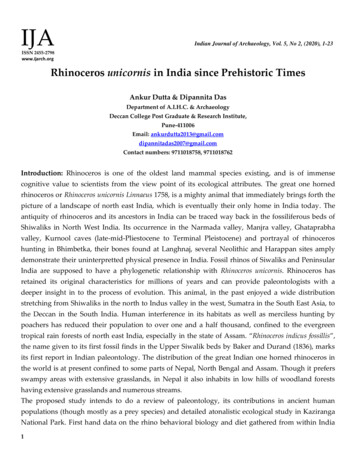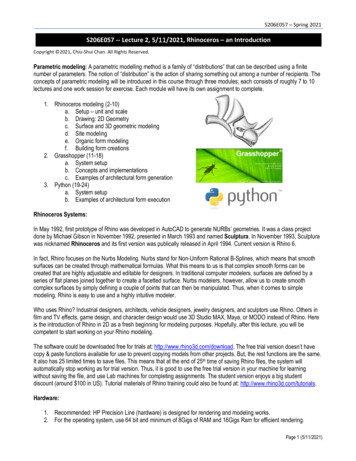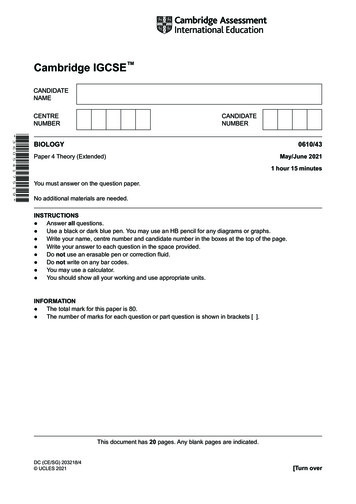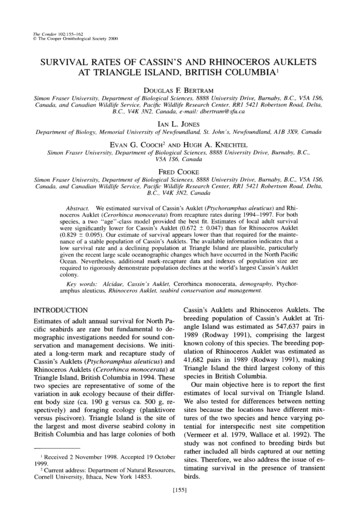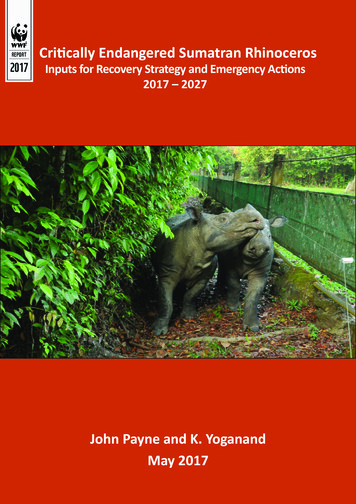
Transcription
Critically Endangered Sumatran RhinocerosInputs for Recovery Strategy andEmergency Actions 2017 – 2027John Payne and K. YoganandMay 2017This report was commissioned by WWF. In general WWF endorsesthe policies and actions recommended, but does not necessarilysupport every detailSumatran Rhinoceros: Recovery Strategy and Emergency Actions 2017 – 2027 i
SUMMARYThe Sumatran rhinoceros (Dicerorhinus sumatrensis) is the most ancient extant rhinoceros. Itemerged in the Miocene about 20 million years ago and is most closely related to the extinct WoollyRhinoceros. The Sumatran rhinoceros was listed as critically endangered in 1996 due to very severepopulation declines and very small clusters of animals remaining. It has gone extinct in almost all ofits former range outside Sumatra and in most localities within Sumatra, including large protectedareas. This critical status continues to date and appears to be worsening. This underlines the urgentneed for a revised strategy, based on a critical review of the past strategies, an assessment of thecurrent status, and an analysis of the various factors involved. This report, containing a proposedpolicy and many recommendations for a species recovery strategy, is the result of an effort toaddress this need. This report can be seen as an input for the Indonesian National Sumatran RhinoStrategy and Action Plan 2017 -2027 and as a basis for WWF’s strategy and possible role to supportthe Government Strategy and Plan.Currently, the main biological issue with Dicerorhinus is the extremely small, declining population,whereby individuals are too scattered to sustain adequate breeding to prevent extinction. Inhindsight, this could be characterised as a “declining population” problem, where insufficient rhinonumbers in any one location, ‘Allee Effect’ and reproductive pathology of female rhinos pose thebiggest demographic hurdles to species survival and population growth. Poaching, in recent decadesparticularly through snaring, is a constant risk to all remaining rhinos and was the major contributoryreason for their decline until about 1980s.What is a viable Sumatran rhino population size? The question was answered at the Sumatran RhinoCrisis Summit in 2013 and again in 2015 by Caroline Lees (Miller et al 2015). The answer is: at least20 rhinos with a roughly equal sex ratio, no inbreeding depression and an inter-birth interval ofthree years. We know from accumulated observations of the species over the past five decades,however, that for any cluster of wild Dicerorhinus, even if there are 20 rhinos, at least some femalesare reproductively compromised, and overall they are not producing offspring at an inter-birthinterval of three years. We can assume that all clusters have some degree of inbreeding.Currently, a significant population consisting of 20 rhinos and showing signs of breeding isreported (by Aceh based NGOs) to occur in the western part of Leuser Ecosystem. A smallerpopulation but with some breeding is reported by YABI to occur in Way Kambas National Park. Inother parts of Leuser Ecosystem, Bukit Barisan Selatan National Park and the interior forests of EastKalimantan there are definite signs of only a few rhinos each. With the exception of West Leuser, nowild Dicerorhinus cluster appears large enough to be viable. All other wild rhino clusters will drift toextinction, with or without poaching.The conservation strategies since 1960s until recently were focused on reducing the threat ofpoaching, including establishing protected areas and rhino protection units, and on conductingpopulation surveys. In the past, rhino conservation strategies did not address the seriousSumatran Rhinoceros: Recovery Strategy and Emergency Actions 2017 – 2027 ii
demographic problem of poor reproduction. The establishment of Sumatran Rhino Sanctuary (SRS)in 1997, which has the aim of building a captive population, was a suitable strategy. But the breedingeffort and output did not match the need to counter the widespread and serious yet invisibleproblem of very few scattered rhinos and not enough births.Intensive Protection Zone (IPZ) and Intensive Management Zone (IMZ) concepts are currently beingdiscussed in Indonesia as new strategies. However, IPZ is a new name for an old approach, directedtowards the poaching threat without addressing low birth rate. IMZ involves capturing scatteredrhinos and translocating them into large fenced areas in order to promote natural breeding. Thisapproach is partly directed at the low birth rate problem but, due to many issues that we identify inthis report, not least that there are not enough fertile rhinos left in the wild to form an IMZpopulation, it is unsuitable for Dicerorhinus in the current situation. SRS has proven to be verysuitable for husbandry and breeding of rhinos. Therefore, all rhinos captured should be maintainedin facilities of a similar design, i.e. small individual paddocks with night stalls, one unit per rhino(termed “rhino sanctuary”). There is no need to experiment with IMZs or with translocating capturedrhinos back “into the wild” for consolidation of the currently unviable clusters. These experimentalapproaches will not make best use of precious female and male gametes, and should not beattempted with a species on the verge of extinction.The days of “conserving” Sumatran rhino are gone. The species is in advanced crisis mode. Tofacilitate the species recovery program, we outline below a broad policy that we believe is necessaryto prevent extinction, and to be adopted in Indonesia and globally.Proposed policy for the species recovery programThe argumentation leading to the proposed policy is detailed in this report. The proposed policy isplaced here, at the beginning of the report, in order to emphasise the urgent need for change, notonly within WWF, but nationally and internationally, and without further delay.Dicerorhinus is on the verge of extinction.Dicerorhinus is a unique and ancient genus. Its extinction will represent the first terrestrial mammalgenus extinction globally since 1936. Responsibility to prevent its extinction now lies ultimately withGovernment of Indonesia.Civil society, national and international organisations and other governments can potentially assist,but none can take the key decisions for actions now needed to prevent extinction.Previous actions recommended, and still being implemented, to prevent extinction of Dicerorhinushave focused on counting wild rhinos, on reducing rhino deaths, on consulting stakeholders, onawareness, on fund-raising and on reducing habitat loss and promoting habitat restoration.Together, they have failed to halt the decline in numbers because the most crucial action ofincreasing rhino births has not been prioritised.Sumatran Rhinoceros: Recovery Strategy and Emergency Actions 2017 – 2027 iii
The new paradigm to prevent the extinction of Dicerorhinus has the following key features:· One recovery program.· Focus on increasing the number of rhino births.· Ensure that every remaining Dicerorhinus rhino is facilitated to contribute to the survival of thegenus, and that every rhino, whether reproductively optimum or not, contributes eggs or spermor cells.· Facilitate movement of rhinos and gametes among conservation areas and captive facilities as apopulation management tool to promote rhino births.· Bring two forms of wild rhinos into rhino sanctuaries: (a) young fertile rhinos (for naturalbreeding, to quickly boost captive birth rates) and (b) old and reproductively disabled rhinos (ascandidates for application of assisted reproductive technology, ART).· Focus on preventing extinction and on eventual overall population growth rather than trying toprotect every isolated cluster of rhinos.· Base decisions on science and the advice of Dicerorhinus experts, including rhino veterinariansand reproductive biology experts.· Make the policy and then seek the necessary financing to implement the actions that supportthe policy (do not seek funds based on what funds seem to be available at the current time).· Seek and employ the best people for the agreed actions.These policies, and the analyses, views and recommendations made in this document represent aradical change from those that have been made in relation to Sumatran rhinoceros elsewhere overthe past few decades, including those contained in the 2007-2017 “Strategy and action plan for theconservation of rhinos in Indonesia: Rhino Century Program”. The recommended policy change canbe summarized as shifting from monitoring and counting rhinos, and from preventing rhino deaths,to making sure that all Sumatran rhinos contribute to making more Sumatran rhinos. A longer term(30 – 50 years) goal of reintroducing Dicerorhinus from captive stock to suitable natural habitats (notnecessarily the mountainous protected areas where the remnant rhinos currently linger) for in situmanagement is implicit in the proposed new paradigm.This policy can lay a foundation for the new governmental strategy and action plan that will beneeded to replace the 2007-2017 plan.We suggest that WWF-Indonesia takes up six very significant roles to play:1. To be the institution that introduces the need for a shift away from the prevailing focus oncounting and protecting free-ranging rhinos in protected areas to the new paradigm outlined inthis report.2. To sustain that shift by continuing to advise government, and in effect drive the new strategy,even though it is not necessary to take a lead in implementing some of the actions of the strategy(such as captive breeding).3. To bring in and support the introduction of new players in Sumatran rhino efforts, includingphilanthropists (for Indonesian sources of funds), lobbyists (to secure greater political support)and land-owners (for potential locations of new sanctuary facilities).4. To advocate the establishment of a new unit or agency to lead the Dicerorhinus recoveryprogram, under the Ministry of Environment and Forestry (and in coordination with thePresident’s office).Sumatran Rhinoceros: Recovery Strategy and Emergency Actions 2017 – 2027 iv
5. To continuously monitor all aspects of Dicerorhinus, including conservation actions beingundertaken, and alert government to changes that might be needed in policies and actions.6. To reach out to the relevant stakeholders and convince them about the merits of the well-studiedpositions and evidence based decisions taken by WWF on Sumatran rhinoceros.The single recovery program we propose here is meant to manage all species recovery work,including capture and translocation, and management of all present and future rhino sanctuaries inIndonesia. The main aim of the program is to assist every remaining rhino to allow its gametes (eggsor sperm) to contribute towards making rhino calves, including through advanced reproductivetechnology, and thereby maximise rhino reproduction.We deduce that decision-making on rhino captures depends largely on logistical issues, and not onthe number of rhinos in one locality, except in the case of West Leuser. Except for West Leuser, thelonger rhinos remain in situ, the less each one can contribute to the survival of its species. Thus, forfertile females, the intention is that birth rate is maximised. For fertile males, the intention is tomake best use of the sperm. For sub-fertile females, oocytes are to be removed and fertilized invitro, for implantation of embryos into surrogate mothers. We argue that rhino capture should startas soon as possible at all sites: Kutai Barat (work is already underway and permission granted forcapture of the few rhinos in “pocket 3”), Aceh (Leuser Ecosystem) , Bukit Barisan Selatan (theremaining rhinos are not viable) and Way Kambas (best hope to secure more fertile females). If thepreliminary report on existence of a viable population in West Leuser, Aceh, can be confirmed, thenpractice in situ management and robust population monitoring in an adaptive managementframework. However, some fertile females should be removed from Aceh in order to help build aviable and growing captive population.In terms of leadership on species recovery strategy, our comparative analysis suggests that all themajor institutions that could potentially take up the leadership role need to fill major gaps inessential requirements in order to be the leader. A new government-instituted special unit or agencyunder MoEF, established for the specific purpose of preventing the extinction of Dicerorhinus,appears to have the best chance of providing effective leadership. By definition, the leadership hasto be an institution or an individual office-bearer in that institution, and cannot be a collection ofinstitutions (i.e. not the rhino task force or the NGO consortium). The collection of institutionsinvolved in preventing the extinction of Dicerorhinus can play the role of advisors and partners tothe lead institution.The key and immediate needs for the leader to agree on are:(1) that government needs to put in place a policy along the lines presented in this report for thespecies recovery, authorize the lead agency to implement the special programme and allocate fundsto prevent the extinction of Dicerorhinus;(2) that there will be one programme managed by a competent team (not several programmes indifferent places run by different institutions);(3) that the goal of the programme is to maximise number of births of Dicerorhinus and productionof Dicerorhinus embryos;(4) that capture of wild rhinos will be authorized and commence as soon as possible fromKalimantan, BBS, Way Kambas and Aceh;Sumatran Rhinoceros: Recovery Strategy and Emergency Actions 2017 – 2027 v
(5) that simple low cost facilities probably need to be built in suitable sites to hold several rhinos inthe next three years; and(6) advanced reproductive technology needs to be applied to Sumatran rhinos in fenced, managedfacilities, as a means to produce additional embryos.Finally, we make the following conclusions: Dicerorhinus will very likely go extinct in the absence ofquick, decisive actions, because the main problems in recent years have been and still are longdelays in decision-making, and implementation of wrong decisions that have been made largelybecause of cognitive biases. There are now three options open: (a) make the best decisions now forpreventing the extinction, as elaborated in this report, and implement them, and / or (b) delegatepreventing extinction of Dicerorhinus to land-owners and private individuals (as happenedsuccessfully with African rhinos, and American and European bisons), or (c) cease making any furtherefforts and allow extinction to happen.Sumatran Rhinoceros: Recovery Strategy and Emergency Actions 2017 – 2027 vi
Table of ContentsSUMMARY. iiTable of Contents .viiList of Figures . xList of Tables .xiList of Appendices . xiiGlossary . xiiiFOREWORD . xvACKNOWLEDGEMENTS . xvii12INTRODUCTION . 11.1Significance of Dicerorhinus . 11.2Why was Sumatran rhinoceros assessed as “critically endangered”? . 11.3The urgency to develop a recovery strategy and emergency actions . 11.4Purpose of this report . 2ECOLOGICAL AND CONSERVATION HISTORY OF DICERORHINUS . 32.1Range contraction and population decline over a century . 32.2Natural history of the Sumatran rhino . 52.3What does history tell us about optimal habitat for Sumatran rhino? . 62.4Conservation History of Dicerorhinus . 72.5Lessons to be learnt from the historical trajectory in Sabah. 82.6History of captive breeding efforts . 92.6.13Lessons learned in the first attempt to capture rhinos in Kalimantan . 10CURRENT CONSERVATION STATUS OF DICERORHINUS. 123.1Current locations and population status . 123.1.1Way Kambas, Lampung . 123.1.2Bukit Barisan Selatan, Lampung . 123.1.3Leuser Ecosystem, Aceh. 133.1.4Kutai Barat – Mahakam Ulu, East Kalimantan . 133.2Main threats and factors affecting population growth . 143.2.1Low birth rate . 143.2.2Insufficient numbers in one location. 143.2.3Allee Effect . 14Sumatran Rhinoceros: Recovery Strategy and Emergency Actions 2017 – 2027 vii
3.2.4Inbreeding . 153.2.5Reproductive pathology . 153.2.6Disease . 163.2.7Poaching. 163.3Past conservation approaches . 173.4A review of current conservation strategies . 173.4.1Rhino Protection Units. 173.4.2Distribution and Population Surveys . 183.4.3Intensive Protection Zone (IPZ) . 193.4.4Intensive Management Zone (IMZ) . 203.4.5Sumatran Rhino Sanctuary . 213.4.6Reduction of encroachment into BBS. 213.4.7Awareness. 213.4.8PVA and PHVA for Dicerorhinus . 213.4.9Sumatran Rhino Crisis Summit (2013) resolutions and follow-ups . 233.4.10Sumatran rhino 10-year strategic plan log-frame (2016) . 243.54Factors hindering effective conservation actions . 253.5.1Irrelevant and ineffective strategies . 253.5.2Undue focus on irrelevant issues . 253.5.3Absence of conservation leadership . 253.5.4Weak collaboration between interested parties . 253.5.5Unsupported research conclusions misguiding conservation actions . 25DICERORHINUS RECOVERY STRATEGY AND EMERGENCY ACTIONS . 274.1One species recovery program . 274.2Captive breeding for maximising rhino reproduction . 304.3In situ management and monitoring of Dicerorhinus . 304.4Capture and translocation . 314.5Rhino sanctuaries . 314.6Advanced Reproductive Technology . 324.7Collaboration with Malaysia . 324.8Existing policy in Indonesia on Sumatran rhinoceros . 334.9Proposed policy for the recovery program and emergency actions . 354.10Decision making for Sumatran rhinos . 364.10.1Should the captured rhinos be kept in the native kabupaten or province? . 39Sumatran Rhinoceros: Recovery Strategy and Emergency Actions 2017 – 2027 viii
4.11Emergency actions for the different Dicerorhinus clusters. 404.12 The main challenges to a consensus on the SR recovery strategy and how to overcomethese? 415PRIORITY ACTIONS FOR WWF AND OTHER STAKEHOLDERS . 435.1WWF-Indonesia role . 435.2Issues on which firm positions to be taken by WWF . 435.3Priority actions for donors . 445.4Indonesian Rhino Joint Secretariat . 445.4.1Who can be the lead organization to implement the recovery strategy?. 445.5OTHER RECOMMENDATIONS . 455.6CONCLUSIONS. 476REFERENCES . 487APPENDICES . 55Sumatran Rhinoceros: Recovery Strategy and Emergency Actions 2017 – 2027 ix
List of FiguresFIGURE 2.1. EXTENT OF EXPOSED LAND IN SUNDALAND 20,000 YEARS AGO DALAND/) . 4Sumatran Rhinoceros: Recovery Strategy and Emergency Actions 2017 – 2027 x
List of TablesTABLE 2.1. ILLUSTRATION OF DECLINE IN DICERORHINUS AS A RESULT OF RISING SEA LEVEL AND HUMAN HUNTING * ------------------ 5TABLE 3.1. REPRODUCTIVE PATHOLOGY IN CAPTIVE BRED AND WILD SUMATRAN RHINOS CAPTURED IN MALAYSIA AND INDONESIAAFTER 1984 (SOURCE: NAN SCHAFFER AND CO-AUTHORS; APPENDIX 4). ----- 16TABLE 4.1. THE FOUR MAJOR DECISIONS TO BE MADE FOR SUMATRAN RHINOS AND THE CRITERIA BASED ON WHICH DECISIONS COULDBE MADE. ----------------------- 37TABLE 4.2. EMERGENCY ACTIONS NEEDED FOR THE DIFFERENT RHINO CLUSTERS TO PREVENT EXTINCTION AND IMPLEMENT THERECOVERY STRATEGY FOR DICERORHINUS. -------------------------------------- 40Sumatran Rhinoceros: Recovery Strategy and Emergency Actions 2017 – 2027 xi
List of AppendicesAPPENDIX 1. CONSERVATION EXPERTS CONSULTED FOR THIS WORK . 55APPENDIX 2. RE-DISCOVERY OF SUMATRAN RHINO IN KALIMANTAN . 56APPENDIX 3. HISTORY OF CAPTIVE BREEDING EFFORTS . 59APPENDIX 4. REPORT ON REPRODUCTIVE PATHOLOGY IN CAPTIVE BRED AND WILD SUMATRAN RHINOS CAPTURED IN MALAYSIA ANDINDONESIA; BY DR. NAN SCHAFFER AND CO-AUTHORS (MARCH 2017) . 62APPENDIX 5. HOW TO DISTINGUISH SUMATRAN RHINO AND MALAYAN TAPIR FAECES AND FOOTPRINT IN THE FIELD? . 68APPENDIX 6. HOW MANY SRS TYPE FACILITIES ARE NEEDED? WHERE? WHAT ARE THE SPECIFICATIONS OF THE “RHINOSANCTUARIES” AND REQUIREMENTS OF THE ‘INTERIM’ FACILITIES? . 74APPENDIX 7. MORE BACKGROUND ON DICERORHINUS . 77APPENDIX 8. UNPUBLISHED INFORMATION ON DICERORHINUS IN EAST KALIMANTAN . 82APPENDIX 9. SUMATRAN RHINO REPRODUCTION NOTES FROM NAN SCHAFFER . 84APPENDIX 10. SUMATRAN RHINO CRISIS SUMMIT (APRIL 2013): AN ASSESSMENT OF PROGRESS 18 MONTHS LATER.REPORT PREPARED BY J. PAYNE, EXECUTIVE DIRECTOR, BORA. OCTOBER 2014. . 86APPENDIX 11. A COMPARATIVE ASSESSMENT OF POSSIBLE LEAD AGENCIES . 92Sumatran Rhinoceros: Recovery Strategy and Emergency Actions 2017 – 2027 xii
GlossaryAllee effect – positive correlation between population density and individual reproductive fitness,implying that the smaller a population, the lower the fitness and accordingly low prospects forpopulation survival.AREAS – Asian Rhino and Elephant Action StrategyART – Assisted Reproductive Technology (also known as “advanced reproductive technology”)BBS – Bukit Barisan Selatan (National Park)BORA – Borneo Rhino AllianceBP – years before presentBRS – Borneo Rhino Sanctuary (located in Tabin Wildlife Reserve, Sabah, Malaysian Borneo)Cluster – two or more remnant rhinos occurring in an isolated area that together are very unlikely toconstitute a viable population over the medium to long term.Dicerorhinus – we interchangeably use this genus name with Sumatran rhino to emphasize that notjust a species but a mono-specific genus is likely to go extinct.EoF – Eyes on the ForestFKL – Forum Konservasi Leuser (Leuser Conservation Forum)ha - hectaresGMPB – Global Management and Propagation BoardIMZ – Intensive Management ZoneIPB – Institut Pertanian Bogor (Bogor Institute of Agriculture)IPZ – Intensive Protection ZoneIRF – International Rhino FoundationIUCN – International Union for Conservation of Nature and Natural ResourcesMeta-population – a group of populations of a species that are separated by space yet interact, asindividual members move (or get moved) from one population to another. A key characteristic of ameta-population survival is one or more source populations, where the population grows and cansupply individuals to repopulate other occupied or unoccupied areas.MoEF – Ministry of Environment and Forestry, Government of IndonesiaNGO – Non Governmental OrganizationNP – National ParkPA – Protected Area (used synonymously with conservation areas in Indonesian context)PHVA – Population and Habitat Viability analysisPVA - Population Viability AnalysisRhino Sanctuary – fenced facilities where rhinos are maintained under close care, with adjacent unitsof small forest paddocks with night stall, one unit per rhino. This design allows constant monitoringof every rhino, and the potential to apply advanced reproductive technology.RPU – Rhino Protection UnitRSPO – Roundtable for Sustainable Palm OilSMART – Spatial Monitoring and Reporting ToolSRCS – Sumatran Rhino Crisis Summit (also referred as “crisis summit”)SRS – Sumatran Rhino SanctuarySumatran Rhinoceros: Recovery Strategy and Emergency Actions 2017 – 2027 xiii
Sub-population – group of rhinos occurring in an area that are breeding and likely
Sumatran Rhinoceros: Recovery Strategy and Emergency Actions 2017 – 2027 v 5. To continuously monitor all aspects of Dicerorhinus, including conservation actions being undertaken, and alert government to
